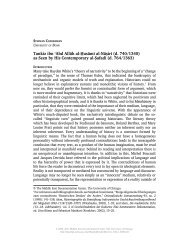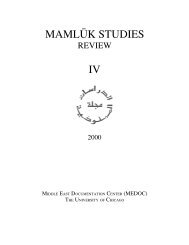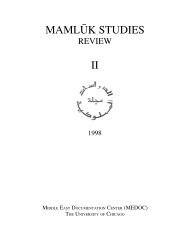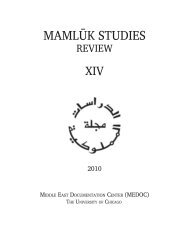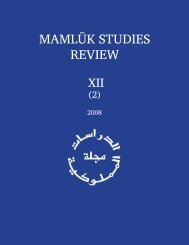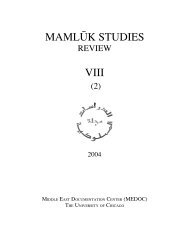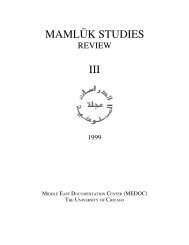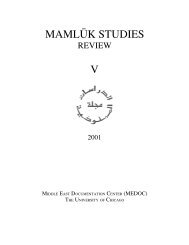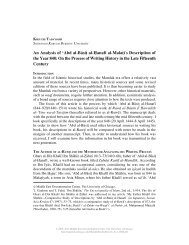- Page 1 and 2: MAMLU±K STUDIES REVIEW VI 2002 MID
- Page 3 and 4: © 2002, 2012 Middle East Documenta
- Page 5 and 6: MAMLU±K STUDIES REVIEW Editor BRUC
- Page 7 and 8: X CONTENTS Qa≠ytba≠y's Diplomat
- Page 9 and 10: W. W. CLIFFORD THE UNIVERSITY OF CH
- Page 11 and 12: MAMLU±K STUDIES REVIEW VOL. 6, 200
- Page 13 and 14: MAMLU±K STUDIES REVIEW VOL. 6, 200
- Page 15 and 16: MAMLU±K STUDIES REVIEW VOL. 6, 200
- Page 17 and 18: DONALD P. LITTLE MCGILL UNIVERSITY
- Page 19 and 20: MAMLU±K STUDIES REVIEW VOL. 6, 200
- Page 21 and 22: MAMLU±K STUDIES REVIEW VOL. 6, 200
- Page 23 and 24: MAMLU±K STUDIES REVIEW VOL. 6, 200
- Page 25: MAMLU±K STUDIES REVIEW VOL. 6, 200
- Page 29 and 30: STEPHAN CONERMANN AND SUAD SAGHBINI
- Page 31 and 32: MAMLU±K STUDIES REVIEW VOL. 6, 200
- Page 33 and 34: MAMLU±K STUDIES REVIEW VOL. 6, 200
- Page 35 and 36: MAMLU±K STUDIES REVIEW VOL. 6, 200
- Page 37 and 38: MAMLU±K STUDIES REVIEW VOL. 6, 200
- Page 39 and 40: MAMLU±K STUDIES REVIEW VOL. 6, 200
- Page 41 and 42: MAMLU±K STUDIES REVIEW VOL. 6, 200
- Page 43 and 44: 34 STEPHAN CONERMANN AND SUAD SAGHB
- Page 45 and 46: 36 STEPHAN CONERMANN AND SUAD SAGHB
- Page 47 and 48: MAMLU±K STUDIES REVIEW VOL. 6, 200
- Page 49 and 50: MAMLU±K STUDIES REVIEW VOL. 6, 200
- Page 51 and 52: MAMLU±K STUDIES REVIEW VOL. 6, 200
- Page 53 and 54: MAMLU±K STUDIES REVIEW VOL. 6, 200
- Page 55 and 56: MAMLU±K STUDIES REVIEW VOL. 6, 200
- Page 57 and 58: MAMLU±K STUDIES REVIEW VOL. 6, 200
- Page 59 and 60: LUCIAN REINFANDT CHRISTIAN-ALBRECHT
- Page 61 and 62: MAMLU±K STUDIES REVIEW VOL. 6, 200
- Page 63 and 64: MAMLU±K STUDIES REVIEW VOL. 6, 200
- Page 65 and 66: MAMLU±K STUDIES REVIEW VOL. 6, 200
- Page 67 and 68: MAMLU±K STUDIES REVIEW VOL. 6, 200
- Page 69 and 70: MAMLU±K STUDIES REVIEW VOL. 6, 200
- Page 71 and 72: ROBERT IRWIN LONDON, ENGLAND The Pr
- Page 73 and 74: MAMLU±K STUDIES REVIEW VOL. 6, 200
- Page 75 and 76: MAMLU±K STUDIES REVIEW VOL. 6, 200
- Page 77 and 78:
MAMLU±K STUDIES REVIEW VOL. 6, 200
- Page 79 and 80:
DORIS BEHRENS-ABOUSEIF SCHOOL OF OR
- Page 81 and 82:
MAMLU±K STUDIES REVIEW VOL. 6, 200
- Page 83 and 84:
MAMLU±K STUDIES REVIEW VOL. 6, 200
- Page 85 and 86:
MAMLU±K STUDIES REVIEW VOL. 6, 200
- Page 87 and 88:
MAMLU±K STUDIES REVIEW VOL. 6, 200
- Page 89 and 90:
MAMLU±K STUDIES REVIEW VOL. 6, 200
- Page 91 and 92:
MAMLU±K STUDIES REVIEW VOL. 6, 200
- Page 93 and 94:
MAMLU±K STUDIES REVIEW VOL. 6, 200
- Page 95 and 96:
MAMLU±K STUDIES REVIEW VOL. 6, 200
- Page 97 and 98:
MAMLU±K STUDIES REVIEW VOL. 6, 200
- Page 99 and 100:
MAMLU±K STUDIES REVIEW VOL. 6, 200
- Page 101 and 102:
MAMLU±K STUDIES REVIEW VOL. 6, 200
- Page 103 and 104:
LEONOR FERNANDES THE AMERICAN UNIVE
- Page 105 and 106:
MAMLU±K STUDIES REVIEW VOL. 6, 200
- Page 107 and 108:
MAMLU±K STUDIES REVIEW VOL. 6, 200
- Page 109 and 110:
MAMLU±K STUDIES REVIEW VOL. 6, 200
- Page 111 and 112:
MAMLU±K STUDIES REVIEW VOL. 6, 200
- Page 113 and 114:
MAMLU±K STUDIES REVIEW VOL. 6, 200
- Page 115 and 116:
MAMLU±K STUDIES REVIEW VOL. 6, 200
- Page 117 and 118:
MORIMOTO KOSEI NARA, JAPAN What Ibn
- Page 119 and 120:
MAMLU±K STUDIES REVIEW VOL. 6, 200
- Page 121 and 122:
MAMLU±K STUDIES REVIEW VOL. 6, 200
- Page 123 and 124:
MAMLU±K STUDIES REVIEW VOL. 6, 200
- Page 125 and 126:
MAMLU±K STUDIES REVIEW VOL. 6, 200
- Page 127 and 128:
MAMLU±K STUDIES REVIEW VOL. 6, 200
- Page 129 and 130:
MAMLU±K STUDIES REVIEW VOL. 6, 200
- Page 131 and 132:
MAMLU±K STUDIES REVIEW VOL. 6, 200
- Page 133 and 134:
MAMLU±K STUDIES REVIEW VOL. 6, 200
- Page 135 and 136:
MAMLU±K STUDIES REVIEW VOL. 6, 200
- Page 137 and 138:
MAMLU±K STUDIES REVIEW VOL. 6, 200
- Page 139 and 140:
MAMLU±K STUDIES REVIEW VOL. 6, 200
- Page 141 and 142:
134 NIMROD LUZ, ISLAMIZATION IN MAM
- Page 143 and 144:
136 NIMROD LUZ, ISLAMIZATION IN MAM
- Page 145 and 146:
138 NIMROD LUZ, ISLAMIZATION IN MAM
- Page 147 and 148:
140 NIMROD LUZ, ISLAMIZATION IN MAM
- Page 149 and 150:
142 NIMROD LUZ, ISLAMIZATION IN MAM
- Page 151 and 152:
144 NIMROD LUZ, ISLAMIZATION IN MAM
- Page 153 and 154:
146 NIMROD LUZ, ISLAMIZATION IN MAM
- Page 155 and 156:
148 NIMROD LUZ, ISLAMIZATION IN MAM
- Page 157 and 158:
150 NIMROD LUZ, ISLAMIZATION IN MAM
- Page 159 and 160:
152 NIMROD LUZ, ISLAMIZATION IN MAM
- Page 161 and 162:
154 NIMROD LUZ, ISLAMIZATION IN MAM
- Page 163 and 164:
156 NASSER RABBAT, ARCHITECTURE IN
- Page 165 and 166:
158 NASSER RABBAT, ARCHITECTURE IN
- Page 167 and 168:
160 NASSER RABBAT, ARCHITECTURE IN
- Page 169 and 170:
162 NASSER RABBAT, ARCHITECTURE IN
- Page 171 and 172:
164 NASSER RABBAT, ARCHITECTURE IN
- Page 173 and 174:
166 NASSER RABBAT, ARCHITECTURE IN
- Page 175 and 176:
168 NASSER RABBAT, ARCHITECTURE IN
- Page 177 and 178:
170 NASSER RABBAT, ARCHITECTURE IN
- Page 179 and 180:
172 NASSER RABBAT, ARCHITECTURE IN
- Page 181 and 182:
174 NASSER RABBAT, ARCHITECTURE IN
- Page 183 and 184:
176 NASSER RABBAT, ARCHITECTURE IN
- Page 185 and 186:
178 RALPH S. HATTOX, QA≠YTBA≠Y'
- Page 187 and 188:
180 RALPH S. HATTOX, QA≠YTBA≠Y'
- Page 189 and 190:
182 RALPH S. HATTOX, QA≠YTBA≠Y'
- Page 191 and 192:
184 RALPH S. HATTOX, QA≠YTBA≠Y'
- Page 193 and 194:
186 RALPH S. HATTOX, QA≠YTBA≠Y'
- Page 195 and 196:
188 RALPH S. HATTOX, QA≠YTBA≠Y'
- Page 197 and 198:
190 RALPH S. HATTOX, QA≠YTBA≠Y'
- Page 199 and 200:
192 BOOK REVIEWS and ‘A±’ishah
- Page 201 and 202:
194 BOOK REVIEWS For Fatimid histor
- Page 203 and 204:
196 BOOK REVIEWS led to the decay,
- Page 205 and 206:
198 BOOK REVIEWS of Cairo. Behrens-
- Page 207 and 208:
200 BOOK REVIEWS Reading this colle
- Page 209 and 210:
202 BOOK REVIEWS as Wa-ghadatin qad
- Page 211 and 212:
204 BOOK REVIEWS encouraged a corru
- Page 213 and 214:
206 BOOK REVIEWS As indicated by th
- Page 215 and 216:
208 BOOK REVIEWS MUH˝AMMAD AL-SHUS
- Page 217 and 218:
210 BOOK REVIEWS MUH˝AMMAD FATH˝|
- Page 219 and 220:
212 BOOK REVIEWS Muh˝ammad al-Tu
- Page 221 and 222:
214 BOOK REVIEWS Mamluks were less
- Page 223 and 224:
216 BOOK REVIEWS Egyptian society d
- Page 225 and 226:
218 BOOK REVIEWS Qala≠wu≠n's th
- Page 227 and 228:
220 BOOK REVIEWS Ibn Nuba≠tah but
- Page 229 and 230:
222 BOOK REVIEWS However, sawda≠
- Page 231 and 232:
224 BOOK REVIEWS elements hinted at
- Page 233 and 234:
226 BOOK REVIEWS Al-K|la≠n| makes
- Page 235 and 236:
228 BOOK REVIEWS treatises. He sugg
- Page 237 and 238:
230 BOOK REVIEWS program, and artic
- Page 239 and 240:
232 BOOK REVIEWS broad perspective"
- Page 241 and 242:
234 BOOK REVIEWS The contributions
- Page 243 and 244:
236 BOOK REVIEWS moment the Ayyubid
- Page 245 and 246:
238 BOOK REVIEWS remarkable and det



